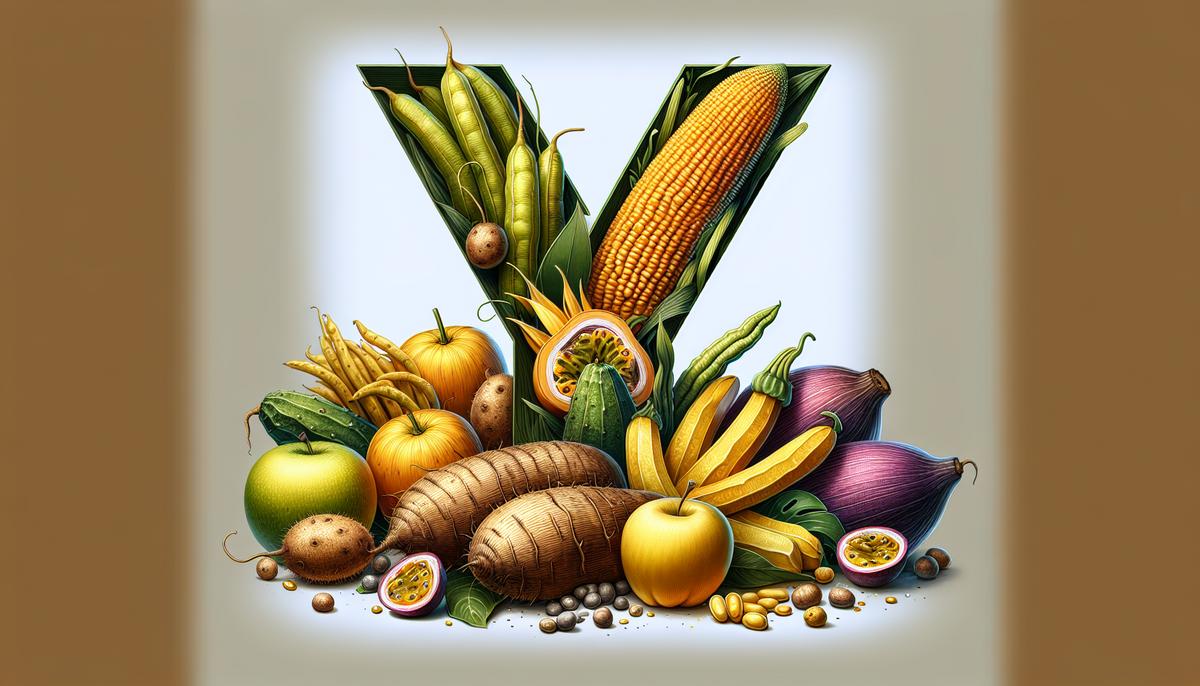There’s a whole universe of fruits and vegetables that begin with the letter “Y,” each offering unique flavors and nutritional benefits. Exploring these can not only diversify your diet but also introduce you to new culinary adventures. From exotic fruits to staple vegetables, these “Y” foods are packed with nutrients and can be prepared in various delicious ways. Whether you’re a seasoned chef or a home cook looking to expand your repertoire, these foods can provide fresh inspiration for your kitchen endeavors. Let’s take a closer look at some remarkable “Y” fruits and vegetables and discover how they can contribute to a healthier and tastier life.
Fruits that start with Y
Yangmei
Yangmei, also known as Chinese bayberry or waxberry, is a small, round fruit with a deep red or purple hue. Its flesh is juicy, with a flavor that balances sweetness and tartness, similar to a mix of strawberry and raspberry. Native to East Asia, Yangmei is often consumed fresh, dried, or used in various culinary applications.
Nutritionally, Yangmei is a powerhouse. It is rich in vitamins C and A, both of which are essential for maintaining a healthy immune system and good vision. Additionally, this fruit contains antioxidants, which help protect the body against free radicals and reduce inflammation. Yangmei also provides dietary fiber, promoting digestive health and helping to keep you full longer.
In the kitchen, Yangmei can be enjoyed in numerous ways. Fresh Yangmei makes a delightful snack or addition to fruit salads. It can also be used to make jams, jellies, and desserts like tarts and pies. In Chinese cuisine, it is sometimes fermented into a type of wine or used to flavor beverages. Its unique flavor can even enhance savory dishes, adding a burst of freshness.
Yellow Passion Fruit
Yellow passion fruit, known for its vibrant yellow skin and aromatic, seedy interior, is a tropical delight. The pulp is tangy and sweet, with a floral aroma that makes it a favorite in many desserts and beverages. Originating from South America, this fruit has gained popularity worldwide for its distinctive taste and versatility.
When it comes to nutrition, yellow passion fruit does not disappoint. It is a rich source of vitamins A and C, which are crucial for immune function and skin health. The fruit is also high in dietary fiber, aiding in digestion and helping to regulate blood sugar levels. Additionally, it contains beneficial plant compounds like polyphenols and carotenoids, which have antioxidant properties.
Culinary uses for yellow passion fruit are plentiful. The pulp can be scooped out and eaten fresh or added to fruit salads for an exotic twist. It is commonly used in smoothies, juices, and cocktails, providing a refreshing and flavorful component. Passion fruit is also a popular ingredient in desserts such as mousses, cakes, and sorbets. For a savory option, try incorporating the pulp into marinades or salad dressings for a zesty kick.
Yellow Watermelon
Yellow watermelon, a lesser-known cousin of the traditional red watermelon, features bright yellow flesh that is both sweet and slightly honey-like. This vibrant fruit can be a delightful surprise at summer picnics and barbecues. It has a similar texture to red watermelon but offers a unique flavor experience.
Nutritionally, yellow watermelon is quite similar to its red counterpart. It is an excellent source of hydration due to its high water content, making it perfect for hot days. It also provides vitamins A and C, which are vital for maintaining good skin and immune health. Additionally, yellow watermelon contains lycopene, an antioxidant that has been linked to heart health and cancer prevention.
Yellow watermelon can be used in various culinary applications. Enjoy it fresh in slices or cubes for a refreshing snack. It can also be blended into smoothies or pureed for a chilled soup. For an innovative salad, combine chunks of yellow watermelon with feta cheese, mint, and a drizzle of balsamic reduction. Its unique color can also enhance fruit platters, adding a vibrant visual appeal.
Yuzu
Yuzu is a citrus fruit originating from East Asia, particularly Japan, Korea, and China. It resembles a small grapefruit with a bumpy rind and can be either yellow or green, depending on ripeness. Yuzu is celebrated for its intensely aromatic and tart juice, which is less sweet than other citrus fruits but highly fragrant.
In terms of nutrition, yuzu is rich in vitamin C, supporting immune health and skin vitality. It also contains antioxidants like flavonoids and limonoids, which help combat oxidative stress in the body. Additionally, yuzu has anti-inflammatory properties and can aid in digestion.
Yuzu’s culinary uses are extensive, especially in Japanese cuisine. The juice and zest are often used to flavor sauces, dressings, and marinades, providing a citrusy zing to dishes. Yuzu is a key ingredient in ponzu sauce, a tangy condiment for dipping or dressing. The fruit is also used in beverages, from teas to cocktails, offering a refreshing and aromatic component. For dessert lovers, yuzu can enhance pastries, cakes, and sorbets with its unique flavor profile.
Vegetables that start with Y
Yam
Yam is a starchy tuber widely consumed in Africa, Asia, and the Caribbean. It comes in various shapes and sizes, with skin that ranges from light brown to dark brown and flesh that can be white, yellow, or purple. Yams are distinct from sweet potatoes, though they are often confused with them.
Nutritionally, yams are a valuable source of complex carbohydrates, providing long-lasting energy. They are rich in dietary fiber, which aids digestion and promotes a feeling of fullness. Yams also contain essential vitamins and minerals, including vitamin C, vitamin B6, and potassium. These nutrients support immune function, brain health, and cardiovascular health.
In the kitchen, yams can be prepared in many delicious ways. They can be boiled, roasted, or mashed, making a versatile side dish. In African cuisine, yams are often pounded into a dough-like consistency called fufu, which is served with soups and stews. They can also be sliced and fried to make yam chips or incorporated into casseroles and gratins. For a sweet treat, try baking yams with a sprinkle of cinnamon and honey.
Yellow Pea
Yellow peas are a type of legume commonly used in soups, stews, and curries. They have a mild, slightly earthy flavor and a creamy texture when cooked. Yellow peas are split and dried, making them a pantry staple that can be stored for extended periods.
Yellow peas are highly nutritious, offering a great source of plant-based protein and dietary fiber. They are rich in vitamins and minerals, including folate, iron, and magnesium, which are essential for overall health. The high fiber content aids in digestion and helps to regulate blood sugar levels, making them a good choice for people with diabetes.
Culinary uses for yellow peas are diverse. They are a key ingredient in split pea soup, a comforting and hearty dish. In Indian cuisine, yellow peas are used to make dal, a spiced lentil stew that pairs well with rice or flatbread. They can also be added to salads, providing a protein boost and a creamy texture. For a unique twist, try making yellow pea hummus, blending cooked peas with garlic, lemon juice, and tahini.
Yellow Potatoes
Yellow potatoes, known for their golden flesh and buttery flavor, are a versatile and popular variety of potatoes. They have a slightly waxy texture, making them ideal for a range of cooking methods. Yellow potatoes are often preferred for their rich taste and smooth consistency.
In terms of nutrition, yellow potatoes are a good source of complex carbohydrates, providing energy and satiety. They contain vitamins C and B6, which support immune function and brain health. Additionally, yellow potatoes offer potassium, which is vital for maintaining healthy blood pressure levels. They also provide some fiber, aiding in digestion.
Yellow potatoes can be used in countless culinary applications. They are excellent for roasting, bringing out their natural sweetness and creating a crispy exterior. Mashed yellow potatoes are creamy and flavorful, requiring less butter or cream than other varieties. They can also be boiled and used in potato salads, offering a tender yet firm texture. For a comforting dish, try making scalloped potatoes, layering thinly sliced yellow potatoes with cheese and cream.
Yucca Root
Yucca root, also known as cassava or manioc, is a starchy tuber native to South America. It has a tough, brown skin and white, starchy flesh. Yucca root is a staple food in many tropical regions and is known for its versatility and mild flavor.
Nutritionally, yucca root is a significant source of carbohydrates, providing energy and satiety. It is rich in dietary fiber, promoting digestive health and helping to regulate blood sugar levels. Yucca root also contains essential vitamins and minerals, including vitamin C, folate, and potassium. These nutrients support immune function, cell growth, and cardiovascular health.
Yucca root can be prepared in a variety of ways. It can be boiled, mashed, or fried, similar to potatoes. In Latin American cuisine, yucca is often used to make fritters, chips, or bread. It can also be grated and used as a base for gluten-free baking. Another popular preparation is yucca fries, which are crispy on the outside and tender on the inside. For a comforting dish, try making yucca root soup, combining the starchy tuber with vegetables and broth.




